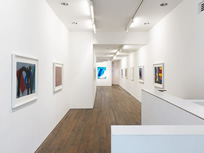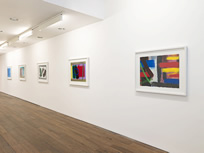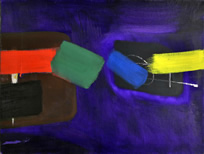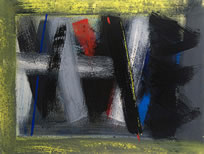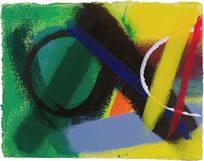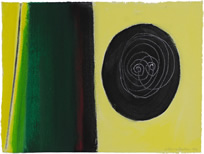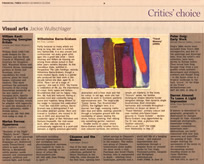Main Gallery
Wilhelmina Barns-Graham
In Perspective: The Late Works
26 March – 17 May, 2014
When Wilhelmina Barns-Graham died in January 2004, she was 91 years old, and was hard at work on an exhibition of new paintings for Art First. The show did indeed take place that April, almost exactly ten years ago. It celebrated her life-long commitment to art, and brought to a close the happy and stimulating final decade of her life as a painter, exhibiting in London with Art First.
In the period since 2004, high profile exhibitions including Tate’s two revelatory survey exhibitions, An Enduring Image in 1999, and posthumously, Movement and Light Imag(ing) Time in 2005; then for her centenary year in 2012, the Fleming Collection and Edinburgh City Art Centre’s presentation, Wilhelmina Barns-Graham: A Scottish artist in St Ives, collectively conveyed the historical sweep of her development from the early years in St Ives in 1940s. At that time she worked amongst a key group of artists who included Ben Nicholson, Barbara Hepworth, Naum Gabo and Alfred Wallis, and she continued alongside the next group of painters who settled there: Peter Lanyon, Roger Hilton, Patrick Heron and Terry Frost. Barns-Graham outlived them all!
This group of artists are the main members of the St Ives group. Because they died before Barns-Graham, their work by now is familiar to collectors and their prices at auction have soared in the past 20 years. Barns-Graham however, kept away from the market mostly because she could afford to, and also because she continued to make new work until as late as 2004. The majority of sales of her historic work still take place privately and as yet there is no significant public record; a fact which is as intriguing as it is refreshing.
The late paintings presented here reveal the same, fundamental dedication to resolving the timeless problems of combining colour, shape and form that informs her entire practice. But in the final decade, while in her eighties, the diversity of her creativity is truly astounding and inspirational. The outpouring of paintings and the powerful late body of prints introduced a new dynamic to her art, reflecting in her own words, a form of “letting rip.” In a conversation with John McEwen, art critic for The Daily Telegraph in 2001, her response on being asked to provide an artistic credo was the following:
‘Now I am at the stage of urgency. My theme is celebration of life, joy, the importance of colour, form, space and texture. Brushstrokes that can be happy, risky, thin, fat, fluid and textured. Having a positive mind and constantly being aware and hopefully being allowed to live longer to increase this celebration.’
The paintings in this exhibition amply endorse her statement, and trace some of the earlier roots that led to the ‘celebration’, the explosion of colour and the high energy of the last years. Barns-Graham’s 'discipline of the mind' as Mel Gooding described it, and the dedication she brought to her practice for over six decades were critical to her sustained artistic evolution. A reassessment of her position within the development of British modern art is now rapidly gaining ground with a new generation of curators, art historians and critics and each exhibition enthralls a new critical audience, which continues to grow.
The Barns-Graham Charitable Trust, established in 1987 during the artist’s lifetime, has overseen Lynne Green’s monograph W Barns-Graham: a Studio Life (2001), updated in 2012, which remains the most comprehensive account of the artist’s life and work. The Trust’s programme of financial support to students of art and art history in art colleges and universities in Scotland and England, is connected to the sale of work, and fulfils the wishes and intentions Barns-Graham expressed when she established the Trust in the first place.
An illustrated catalogue covering the exhibition, and also the Survey of Important Works 1945–1995 presented at the London Art Fair in January 2014, is now viewable in hard copies and online (top of article).
